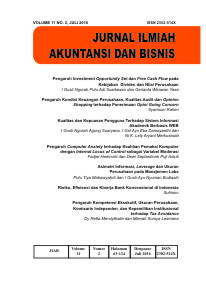Risiko, Efisiensi dan Kinerja pada Bank Konvensional di Indonesia
Abstract
The purpose of this study is to examine the effect of risk, efficiency and performances of conventional banks in Indonesia. Risk variables consist of capital risk which are measured by Capital Adequacy Ratio (CAR), liquidity risk which are measured by Loan to Deposit Ratio (LDR), credit risk which are measured by Non Performing Loan (NPL) and management risk which are measured by Net Interest Margin (NIM). Efficiency is measured by Operating Expense to Operating Income (BOPO) while banking performances are measured by Return on Assets (ROA). The population of this study is all of conventional banks registered in Indonesia Stock Exchange(BEI.) Purposive sampling method is used and the number of samples is 16 banks. We use quarterly data during period of 2013-2014. The hypotheses are tested using multiple linear regression.The result shows that capital risk (CAR) has negative effects, Liquidity risk (LDR) has positive and significant effects, credit risk (NPL) has no significant effects and management risk (NIM) has positive and significant effects on banking performance. Meanwhile, efficiency (BOPO) has significant and negative effects on banking performance.




















